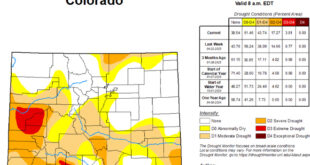“Wildfires are inevitable, but the destruction of homes, ecosystems, and lives is not…”
[ By Katherine Nettles ]
Gunnison County is beginning the process of updating its wildfire prevention and response plans for the future as an increasingly drier climate becomes a reality across the West and the size and scope of wildfires has taken neighboring regions by surprise. According to officials, there is high potential for large wildfires in the area, yet the perception of risk may be lower than reality would indicate and home ignition potential is a key part of the issue.
To address that concern, Gunnison County officials held a public wildfire risk and reduction meeting on March 23 and met with local fire professionals to discuss potential policy changes that might include new risk mapping and new building code amendments. County staff presented an overview of the current Wildland Urban Interface (WUI) code and potential policy recommendations. At the county level, county commissioners would need to approve of any policy changes after they were first vetted through a public outreach process and the county planning commission. Statewide legislation is also being drafted.
The county has engaged with wildfire and fire professionals locally, including the West Region Wildfire Council, Colorado State Forest Service, Gunnison County Emergency Management, the Crested Butte Fire Protection District, Gunnison Fire Protection District and the U.S. Forest Service.
The risks
Cathie Pagano, Gunnison County assistant county manager for community and economic development, reviewed wildfire risks in Gunnison County. These include diverse fuel types from high elevation forests to grass and sagebrush, successful historic fire suppression practices, pine beetle infestation and perception of lower risk than might be warranted. The largest fire in Gunnison County in the past 50 years has been a 1,400-acre fire, reviewed Pagano, yet there is high potential for large wildfires here.
Pagano included excerpts from a 2013 U.S. Forest Service report based on the Forest Sciences Laboratory of the Rocky Mountain Research Station describing how a sequence of conditions and potential consequences can build up to a major wildfire disaster. With severe wildfire potential, extreme burning conditions and residential fires among highly ignitable homes, the sequence demonstrates how firefighting resources can become overwhelmed, and their effectiveness can be reduced or eliminated—resulting in many homes destroyed.
The report states: “Wildfires are inevitable, but the destruction of homes, ecosystems and lives is not… Overcoming perceptions of wildland urban interface fire disasters as a wildfire control problem rather than a home ignition problem, determined by home ignition conditions, will reduce home loss.”
Mike Terrentino from the Colorado State Forest Service pointed out that some homes in the recent Boulder County fires had just been mapped as being “unburnable,” for example.
The response
Pagano presented potential next steps to address the issue, which include following a set of new international wildfire protocols, developing recommendations based on public and stakeholder input and proposing recommendations to the Gunnison County planning commission and municipal councils for consideration.
The Community Planning Assistance for Wildfire (CPAW), established in 2019 to improve outreach and engagement with local stakeholders and constituents and to develop mapping tools and policy, has several recommendations such as defining the wildland urban interface for each area, starting a risk assessment program, adopting the WUI code as a supplement to local adopted building code, updating land use regulations for more resilient approaches to development and using existing plans to support wildfire hazard regulations across Gunnison County.
At the state level, the Colorado Fire Commission and a WUI code subcommittee are drafting recommendations that may be introduced this legislative session. If passed, new legislation could have major impacts such as new eligibility for federal funding that has been unavailable in the past due to lack of an adopted state-wide building code.
Crested Butte Fire District CEO Sean Caffrey said the fire district has historically enforced the fire code in 228 square miles of Crested Butte and beyond. “Protection is the name of the game here, as response under these circumstances…tends to be pretty limited,” he said.
A spokesperson for the West Region Wildfire Council noted that a 2,000-square-foot home is an equivalent of 60,000 pounds of fuel on average. “Once it starts on fire, everything is going to burn,” he said. “[Updating] this plan puts us in a really good spot.”
According to the presentation, embers from a fire are the most important cause of home ignition, and the two most important prevention factors are ignition resistant building materials and designs and adequate defensible space. There was discussion about whether new land use regulation amendments could potentially include new construction only or remodels and even existing structures. While existing homes would be harder to retrofit, “We have a whole lot of housing stock out there already,” said Pagano.
Pagano said county staff will be presenting this information and discussing options such as adoption of the International WUI code to the planning commission at an upcoming meeting. Any county-based recommendations would go through the planning commission, include an additional public input hearing and then back to county commissioners for final review and approval.
Sonja Chavez, manager of the Upper Gunnison River Water Conservancy District, said the UGRWCD is also looking at new mapping in the forest system to identify priorities, and a major concern is water quality. “We have no redundancies of our water sources here, so that’s something we are trying to work on.”
As part of an effort to increase outreach and awareness, stakeholders will be showing some wildfire films in Crested Butte during the month of April.
 The Crested Butte News Serving the Gunnison Valley since 1999
The Crested Butte News Serving the Gunnison Valley since 1999


